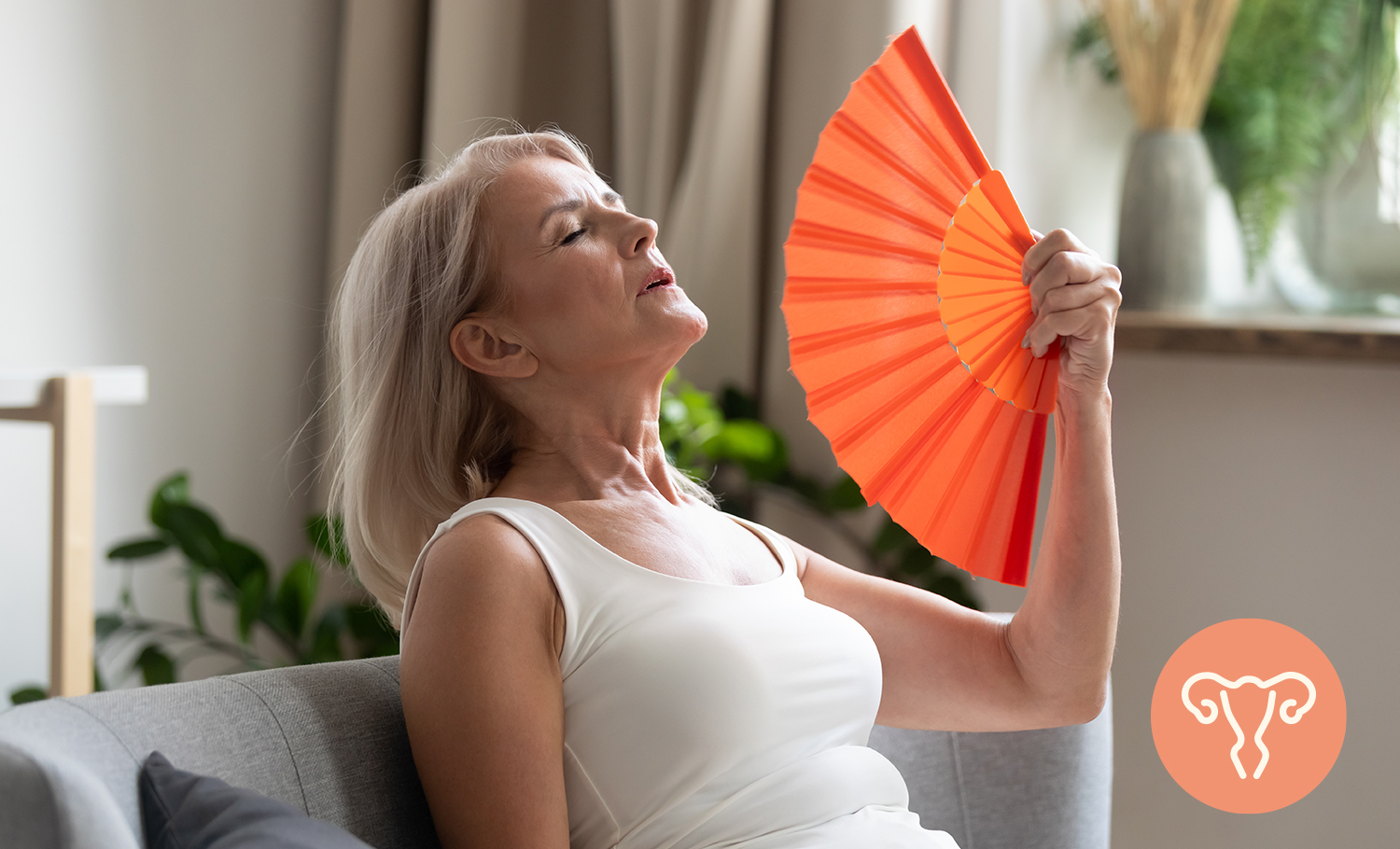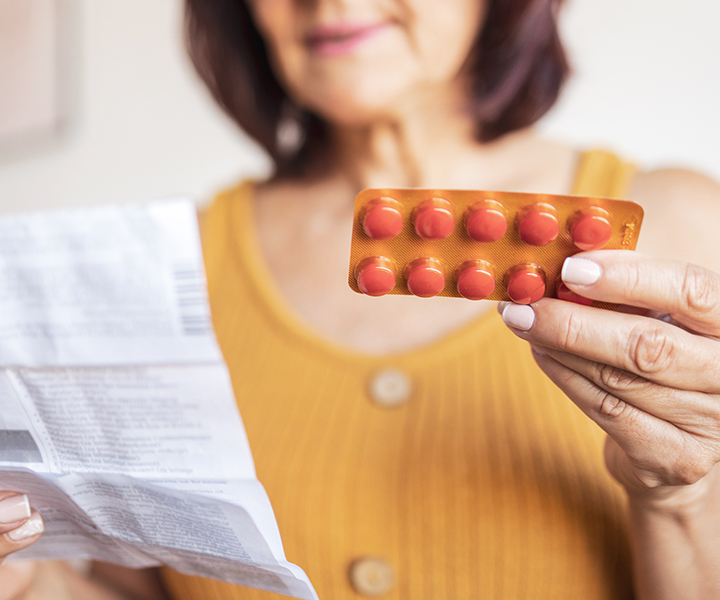What should women expect during the menopause?
30 August 2023 | Comment(s) |
Livia Zimmermann

The symptoms of the menopause are many and can vary greatly from one woman to another. During the menopause, many women experience hot flushes and sweating. But what exactly is the menopause, what happens in a woman's body and can the symptoms be treated? We put these questions to Dr Susanna Weidlinger, Head of Gynaecological Endocrinology and Reproductive Medicine at the University Hospital of Bern. Dr Weidlinger is also President of the Swiss Society of Gynaecological Endocrinology and Menopause.
Groupe Mutuel: What is the menopause?
Dr Susanna Weidlinger: The last menstrual period, which is no longer followed by vaginal bleeding for a year, is called the menopause.

When does the menopause begin and how long does it last?
The menopause generally occurs from the age of 45, on average at 52. The menopause can therefore only be determined retrospectively. An absence of menstruation before the age of 45 is considered an illness and must be medically examined and treated.
The perimenopause is the undefined period of a woman's reproductive life cycle around the menopause, and therefore the transition phase between a woman's fertile life (with ovarian function and regular menstruation) and her infertile life (with definitive cessation of ovarian function and absence of menstruation). It generally occurs between the fourth and fifth decades of life. The duration of the perimenopause varies considerably from one woman to another (5 to 10 years on average). This period, commonly known as the menopause, is marked by profound hormonal changes. Initially, there is often a sharp fluctuation in ovarian activity, resulting in the suppression of the regular menstrual cycle and, therefore, irregular periods. Thereafter, ovarian function declines further and further until it comes to a complete halt. As a result, production of the female sex hormones oestrogen and progesterone gradually stops, and then completely, and menstruation disappears.
The period following the menopause, when all ovarian activity ceases, is known as the postmenopause. During the postmenopause, menstruation ceases. Any vaginal bleeding during this phase is considered suspicious and should be investigated.
A third of women have no or few symptoms during the menopause, a third of women have symptoms but manage very well and, finally, a third of women find their quality of life considerably diminished. In the latter case, medical treatment is required. It should be noted that the average duration of hot flushes and sweating is 7.4 years. Menopausal symptoms therefore often last longer than expected. If symptoms start early in the perimenopause, the average duration of hot flushes and sweating is at least 11.8 years! 10% of women over age 70 still suffer from hot flushes and sweating! The duration of these symptoms cannot be predicted individually.
What happens inside a woman's body? What are the symptoms?
The gradual disappearance of female sex hormones can lead to the appearance of a range of symptoms.
Among the most important are:
- non-specific heart-related problems (palpitations, tachycardia, racing heart, chest tightness)
- sleep disorders (difficulty falling asleep, sleep disturbances, waking up too early)
- depressed mood (discouragement, sadness, crying, lack of motivation, mood swings)
- irritability (nervousness, inner tension, aggressiveness)
- anxiety (inner restlessness, panic)
- physical and mental exhaustion (drop in performance, reduced memory, lack of concentration, forgetfulness)
- sexual problems (changes in sexual desire, changes in sexual activity and pleasure)
- urinary problems (difficulty urinating, frequent need to urinate, involuntary loss of urine)
- vulvovaginal atrophy (vaginal dryness, vaginal burning, discomfort during sexual intercourse)
- joint and muscle problems (joint pain, rheumatic-type problems)
- headaches
- weight changes (such as subjectively inexplicable weight gain)
- skin changes (dry, itchy and more vulnerable skin)
- changes in the menstrual cycle
- changes in hair growth (changes in hair structure and density)

What treatments are available? What can women do to relieve their symptoms?
The treatment of perimenopausal and postmenopausal symptoms must be tailored to each woman's individual needs. Traditional hormone replacement therapy (HRT) is and remains the most effective treatment for hot flushes and sweating. In the event of problems that are perceived as distressing or that limit daily functions, women should be advised to take HRT in accordance with medical recommendations.
A relatively new, non-hormonal and also highly effective option for reducing hot flushes and sweating is the group of drugs known as neurokinin 3 receptor antagonists, of which fezolinetant (45mg/d) is the best known. Cognitive-behavioural therapy has also been shown to be useful, although it does not reduce the frequency of hot flushes, but rather the way in which they are perceived. A reduction in the frequency and severity of hot flushes through weight loss in overweight women has also been clearly demonstrated. Other options include preparations based on black cohosh (5-6.5mg/d), isoflavones (30-80mg/d), red clover, S-Equol, genistein (30-60mg/d), Siberian Rhubarb extract, St John's wort (300mg/d), antidepressants (paroxetine 7.5mg/d) or anti-epileptics (gabapentin 300mg 3x/d) as well as a diet rich in phytoestrogens and, finally, acupuncture. The benefits of sport, deep relaxation techniques, yoga and dietary changes on menopausal disorders have not yet been proven by studies and are unlikely in the opinion of experts. However, the data available on this subject is insufficient.
What about the risk of depression and irritability due to the drop in hormones?
The time window around the menopause presents a higher risk of developing depression than the premenopause and postmenopause. To date, there is insufficient evidence to recommend HRT for the prevention or treatment of perimenopausal depression. Proven therapeutic options for depression (antidepressants, psychotherapy) are also first-choice treatment options for perimenopausal depression.
However, given that there is little scientific evidence that HRT has an antidepressant effect in perimenopausal women, this treatment may be considered to treat mood disorders when psychological symptoms appear following the menopause or worsen at the same time.
What impact does the menopause have on productivity/working life?

Menopausal disorders are a challenge. Not only do they significantly affect quality of life, but also daily work.
Examples of difficulties in the workplace:
- fatigue / daytime sleepiness
- hot flushes and sweating when drinking hot beverages, e.g. coffee with colleagues, or when under psychological stress, e.g. before presenting a project to the team
- general reduction in performance, concentration problems, memory loss, forgetfulness
- irritability, etc.
It is all the more important to remove taboos and de-stigmatise the subject of the menopause, including in the working environment, to strengthen the position of older women as an indispensable workforce and to take measures to integrate them (provision of fans on request, a rest room for a "power nap" if necessary, introduction of flexible working hours, etc.).
What do you recommend?

Following a critical study of HRT worldwide, the general opinion is that the benefits of hormone replacement therapy clearly outweigh the risks. As a hormone treatment specialist, I naturally recommend HRT, given its positive effects, which go far beyond improving menopausal symptoms!
To give just a few examples: HRT has an additional positive effect on metabolic health and body weight. It optimises sugar metabolism, reduces the risk of developing type 2 diabetes mellitus by up to 30% and prevents age-related weight gain. It also has an undeniable beneficial effect on bone metabolism. HRT has been shown to prevent peri- and postmenopausal bone loss, significantly reducing the onset of osteoporosis. HRT is also an authorised treatment option, both for the prevention and treatment of osteoporosis that has already been diagnosed. And these are just some of the many additional benefits of HRT.
At the same time, of course, we recommend adopting a healthy lifestyle, with a healthy diet, sufficient physical activity, quality sleep and stress reduction.
What are the most frequently asked questions about the menopause?
Fear of an increased risk of breast cancer following HRT: with regard to taking HRT after the menopause, studies show that HRT (and especially the combination of oestrogen and a hormone from the corpus luteum) is indeed associated with an increased risk of breast cancer, although this remains minimal compared with other exogenous and endogenous factors. In absolute figures, the absolute risk of breast cancer in a 50-year-old woman increases by 1 to 2 cases per 1000 women/year. This risk is only slightly higher than that observed in women who drink one glass of wine a day, and even lower than in women who drink two glasses of wine a day. It is also similar to the risk described for women who are overweight or not very physically active.
Fear of weight gain following HRT: many women fear weight gain solely as a result of hormone replacement therapy. Yet the data clearly show that women on HRT gain significantly less weight than women without HRT. HRT therefore appears to have a positive effect on weight and body fat distribution. Fears of weight gain following HRT are therefore unfounded.
Do men go through the menopause too? What is the difference with the menopause in women?
The term andropause, sometimes called male menopause or androgen deficiency in ageing men, is controversial.
Over the course of their lives, men experience a gradual and steady decline in their testosterone levels, which is considered to be part of the normal ageing process. From the age of 30, testosterone levels begin to fall by around 1 to 2% a year.
Unlike the menopause, which leads to a rapid loss of female sex hormones and reproductive capacity in women, this hormonal change occurs more slowly in men and does not normally have a direct influence on reproductive capacity.
The symptoms associated with age-related testosterone deficiency in men can be varied and resemble those experienced by women during the menopause:
- tiredness and lack of energy
- reduced libido (sex drive)
- mood swings
- sleep disorders
- reduced muscle mass and bone density
It is important to stress that not all men experience these symptoms and that they may have other causes. If a man notices changes that could indicate a possible lack of testosterone, it is advisable to consult a doctor. The doctor can then check hormone levels using blood tests and, if necessary, recommend appropriate treatments to improve well-being.







